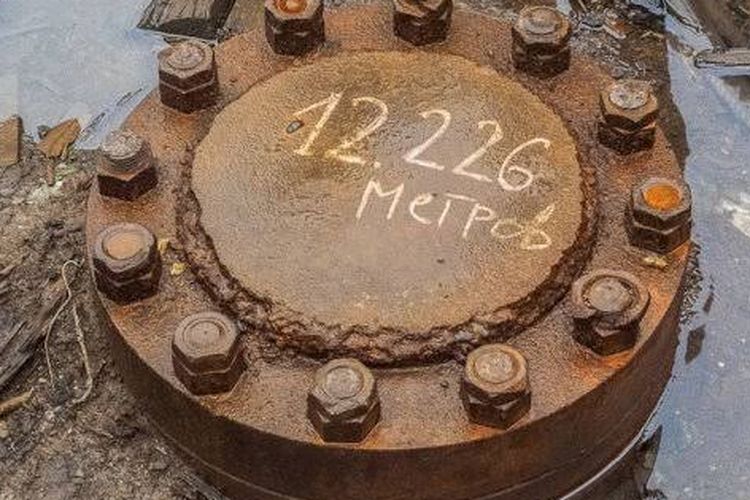
The Kola borehole is on the Kola Peninsula, which is on the Russian border with Norway. It is in the very far north of Russia and is in the Arctic Circle.
The idea to drill into the Earth’s crust appears to have started in America in the 1950s. Scientists wanted to obtain samples of the Mohorovicic discontinuity. This is the boundary between the Earth’s rocky crust and the mantle. It is sometimes called the Moho and it is about 35km thick on average. It is thinner on the ocean floor, which is why the oceans are where they are. It was first identified by Andrija Mohorovicic in 1909. He looked at seismic activity following shallow earthquakes had two types of waves. One set travelled horizontally along the Earth’s crust and the other type were refracted off of a much denser material. He guessed that this would be a different type of rock, probably basalt, and the edge of the Earth’s mantle.
In 1957, an idea was put forward in America to try and drill down to the Moho transition. That same year, the USSR put sputnik into space and the space race started. Beating the Russians at all cost was the goal and there seemed to be no worry about the price. By the early 1960s, the idea was in place and people were ready to go. They wanted to test the theory that the ocean floor is closer to the mantle than other parts of the Earth’s crust, so they decided to start drilling in the sea close to Guadalupe Island. They drilled five holes and the deepest one reached 3,600m. This was a world first. However, despite the scientific possibilities, funding for the project was stopped by congress because it was getting far too expensive, and it was being mismanaged.
The Soviet Union decided to start drilling their own hole into the Earth’s crust. The Kola Peninsula was chosen, and drilling started on 24th May, 1970. After 4 years, the hole had reached 4,000m and they changed the drilling equipment over so they could go deeper. The new goal was 15,000m.
In 1982, 12 years after they started, the hole had reached 11,662m. The first hole was stopped at this depth and a second hole was started from within the first. This hole reached 12,066m when the drill broke. A third hole was started from within the first and this hole reached 12,262m. In 1990, the drill broke in this hole as well and they could go no deeper. They started to drill holes four and five, but they never got as deep as hole three.
By August 1994, it was clear that hole five wasn’t going to go very deep and the project was shelved. It was becoming more and more expensive, and the collapse of the Soviet Union meant that the funds were no longer available.
So, why couldn’t they go deeper than 12,262m? The temperatures at that depth were far higher than anyone had anticipated. In fact, they were almost double the expected temperatures. Also, the rocks decreased in density, while increasing in porosity. That, coupled with the high temperature, made the rock behave almost like a plastic and meant it was almost impossible to drill through it.
On top of that, the temperature was too high for the drill bit. The drillhole was only 23cm wide, and it was impossible to put enough coolant down to keep the drill bit cool. The cost was also incredibly high and the whole process was time-consuming. If there was a problem with the drill bit, they would have to pull out 12km of pipes just to fix it. It gets very difficult to power a drill at the end of a 12km cable and the pressure on the rock walls gets higher and higher. Much further than 12km down and the rock walls would collapse, trapping the drill.
A lot of discoveries have been made thanks to the Kola borehole. Firstly, it was discovered that there isn’t a layer of basalt at the Moho discontinuity. What the seismic waves were bouncing off was a more liquid type of granite, created by the heat and the pressure. Secondly, they found that the rock at that depth was saturated with water. The water came from deep-crust minerals and then got trapped by the impermeable layer of granite. It is probably stored as hydrogen and oxygen atoms that came together during the drilling. Thirdly, they found huge quantities of hydrogen gas. And fourthly, and perhaps most importantly, they found microscopic plankton fossils over 6km below the surface. They found 24 different species of plankton. The rocks they were found in were 2 billion years old.
So, the Kola borehole is a 12,262m deep hole. The goal was to go deeper, but it turned out to be too difficult to do. Many important scientific discoveries were made here. One day, people may be able to drill deeper, but it will not be easy. And this is what I learned today.
Sources:
https://en.wikipedia.org/wiki/Project_Mohole
https://en.wikipedia.org/wiki/Mohorovi%C4%8Di%C4%87_discontinuity
https://en.wikipedia.org/wiki/Kola_Superdeep_Borehole
https://en.wikipedia.org/wiki/Kola_Peninsula
https://www.bbc.com/future/article/20190503-the-deepest-hole-we-have-ever-dug
https://www.atlasobscura.com/places/kola-superdeep-borehole
https://letstalkscience.ca/educational-resources/stem-in-context/deepest-hole-in-world
